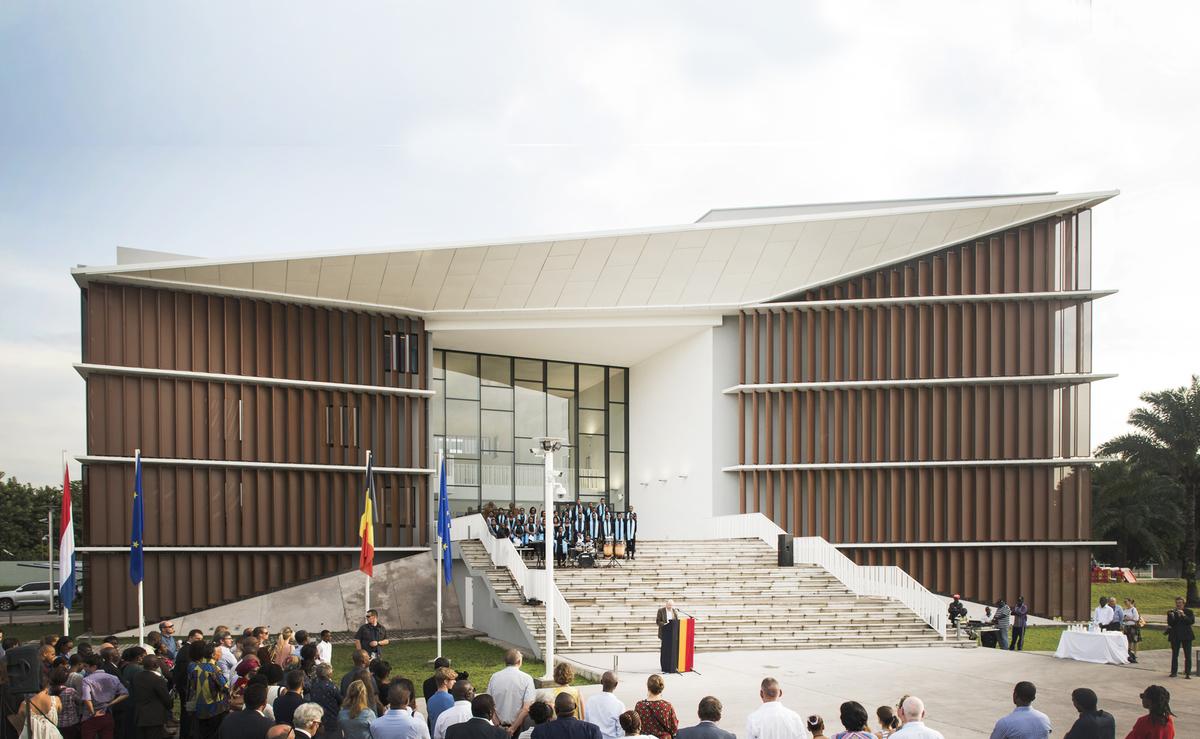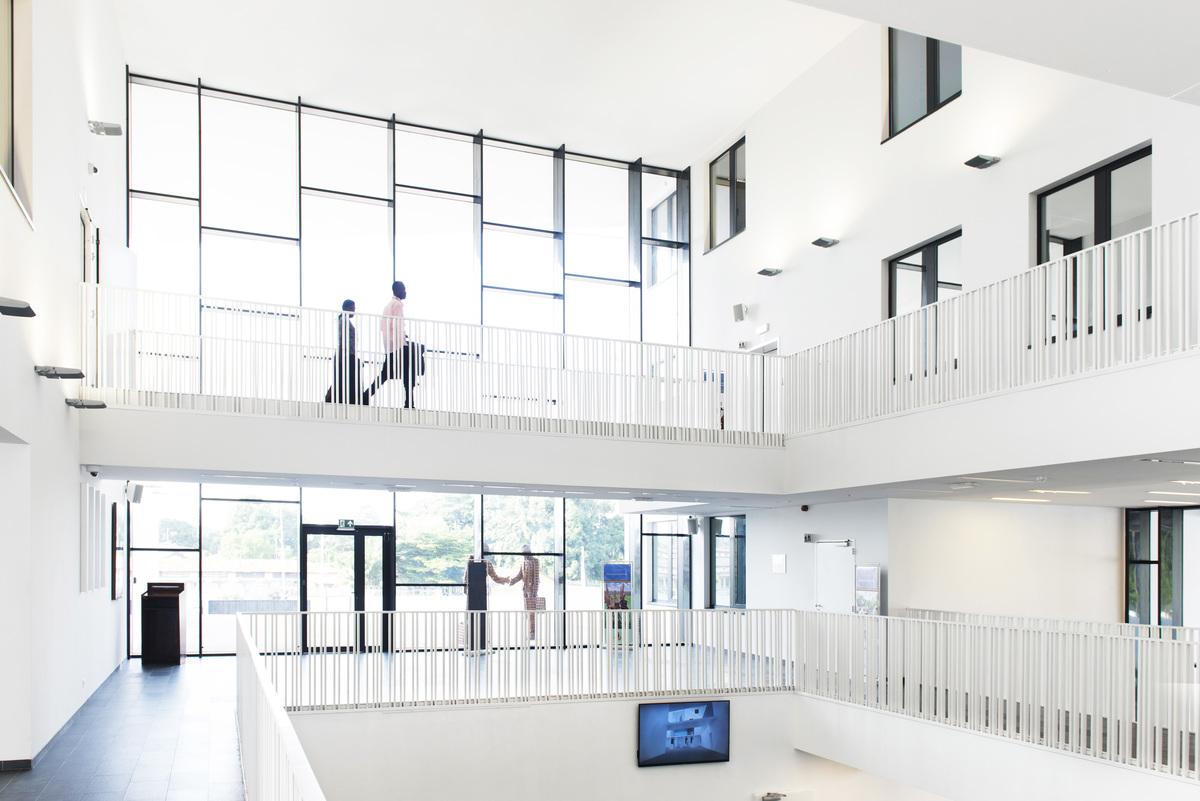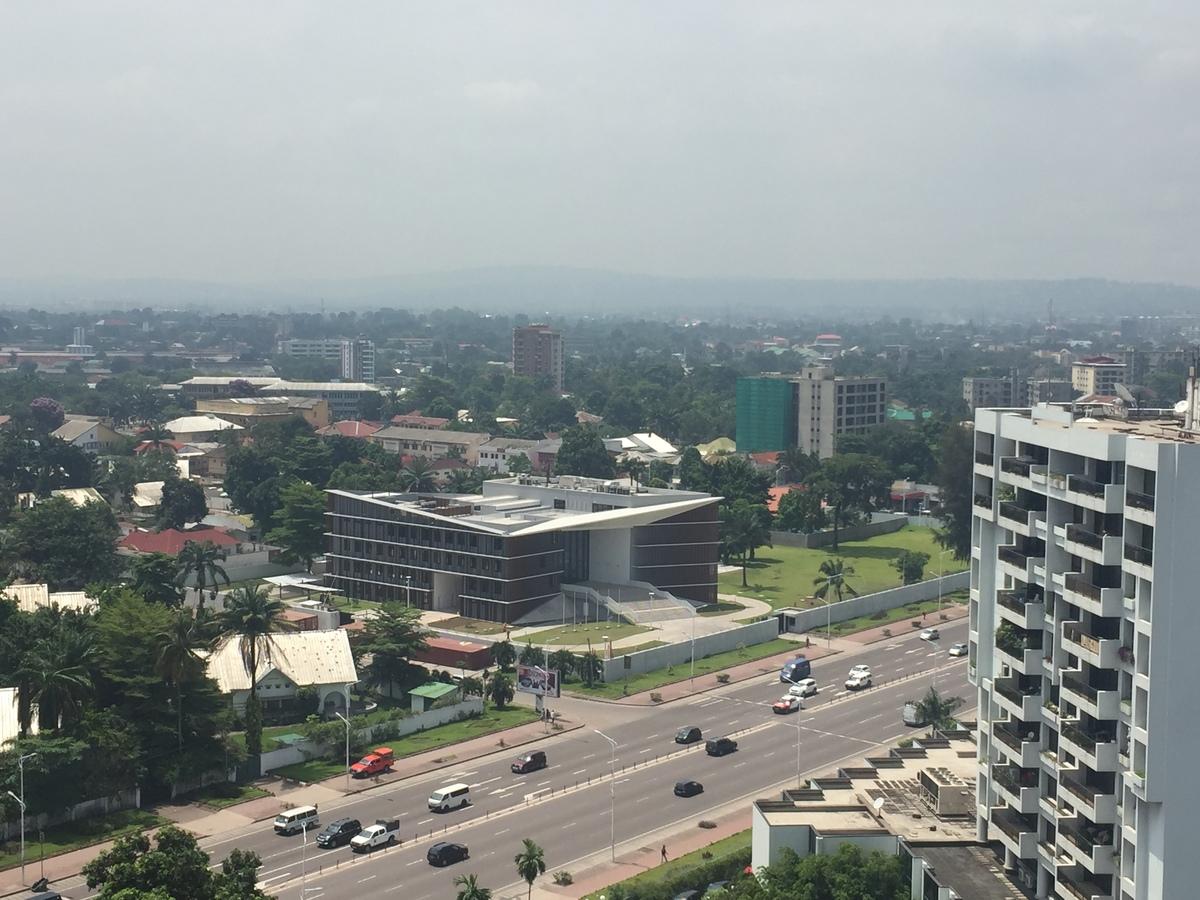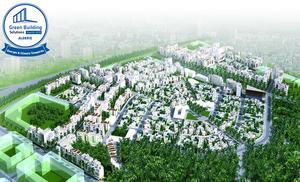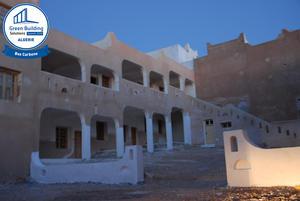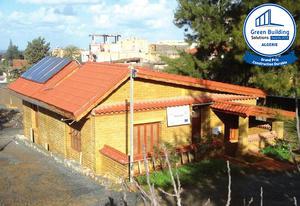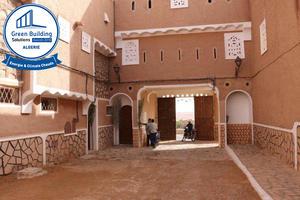Embassy of Belgium & Netherlands, Kinshasa
Last modified by the author on 24/06/2019 - 16:41
New Construction
- Building Type : Other building
- Construction Year : 2016
- Delivery year : 2017
- Address 1 - street : 133 Boulevard du 30 Juin - Gombe 1013 KINSHASA, RD CONGO, Autres pays
- Climate zone : [Af] Tropical Wet. No dry season.
- Net Floor Area : 6 166 m2
- Construction/refurbishment cost : 10 500 000 €
- Number of none : 1 none
- Cost/m2 : 1702.89 €/m2
Certifications :
-
Primary energy need
120 kWhep/m2.an
(Calculation method : Other )
Public building, official image of Belgium in a foreign capital, hosting a heterogeneous program involving the reception of the public and functions to be protected, the embassy is a complex building. To establish its symbolic dimension while ensuring its functionality, we proposed not to outbid this diversity, instead starting from a simple urban layout, allowing a clear and effective sharing of space.
The location of the building, close to the traffic axes, is consistent with its status. Its position on the ground separates the space between this part close to the street and turned towards the reception, towards the outside, of the part turned towards the park, more "inside".
Housing secure spaces, the embassy is primarily a building expressing openness, dialogue, diplomacy. The embassy will consolidate various services at the present time spread across several buildings. A daily entry allows easy access of the public and a clear orientation towards the various services.
The building envelope plays a decisive role. Like the project, it focuses on very different issues.
Facade, she is the face that will present Belgium. It must also meet specific technical constraints. The specific climate of Kinshasa, high heat and humidity, bring special constraints that further increase the importance of the envelope in the design of a passive building. The rains and winds coming to Kinshasa from all directions, the 4 facades must also be protected.
The facade must also incorporate security requirements. Beyond the technical prescriptions, the architectural writing allows a subtle game of uniformity of this envelope thanks to the same pattern generated by the sunshades while performing a variation of the rhythm, by their orientation.
The large hollowed-out volume of the embassy makes it possible to bring light into the very heart of the building. This space in the center of the project, sheltered, but not closed, makes it possible to distinguish each of the departments which make up the whole, while keeping them in a proximity ensuring the operation and the user-friendliness.
The openings, circulation spaces, waiting rooms with glass and closing partitions, services, offices whose partitions are opaque, create a pleasant working environment while ensuring the necessary discretion for the various services of the embassy. From security operations to diplomatic talks, to consular services, all functions find the right degree of confidentiality required.
The comfort of each zone is ensured by the passive design of the whole and the sanitary equipments which allow a precise control of the atmosphere of each space. The light has been specifically designed so that each office has a good brightness without glare thanks to the external sunhades.
As the first passive project in Africa, the standard's criteria had to be adapted to the humid tropical climate of Kinshasa.
Achieving the passive standard is based on insulation, which in this case limits heat transfer from the outside to the inside. The ventilation system allows cooling the incoming air and dehumidifying it, the airtightness of the building reinforcing the action of these devices. Thanks to the extensive study on the sunshine and the physical qualities of the building envelope, it is possible to reduce by about 70% the energy consumption for cooling and dehumidification of the building, so many savings for the planet and the operating budget
If you had to do it again?
Working with the local workforce requires adaptability to all situations. Rather than imposing a constructive system, a method, we must strive to find compromises and solutions with the knowledge already acquired among the workers in order to facilitate the proper implementation of the project and to ensure that the energy objectives and architectural are reached even in the slightest finish ...
See more details about this project
http://www.a2m.be/be-kinshasa/Data reliability
Self-declared
Contractor
Construction Manager
Stakeholders
Designer
A2M
http://www.a2m.be/Local Architect
Structures calculist
Stubeco
-
-
Thermal consultancy agency
Crea-Tec
COPPEN Marc - [email protected]
Dynamic simulations
Other consultancy agency
CES
Special techniques
Designer
Jean-Louis Paquet Architect
-
Construction company
Dematco
https://dematco.net/Contracting method
General Contractor
Owner approach of sustainability
This mission had a dual objective: to create the first passive building in Africa to introduce this standard on the continent and that it becomes a showcase of Belgian excellence in this field.
Architectural description
Public building, official image of Belgium in a foreign capital, hosting a heterogeneous program involving the reception of the public and functions to be protected, the embassy is a complex building. To establish its symbolic dimension while ensuring its functionality, we proposed not to outbid this diversity, instead starting from a simple urban layout, allowing a clear and effective sharing of space.
The location of the building, close to the traffic axes, is consistent with its status. Its position on the ground separates the space between this part close to the street and turned towards the reception, towards the outside, of the part turned towards the park, more "inside".
Housing secure spaces, the embassy is primarily a building expressing openness, dialogue, diplomacy. The embassy will consolidate various services at the present time spread across several buildings. A daily entry allows easy access of the public and a clear orientation towards the various services.
The building envelope plays a decisive role. Like the project, it focuses on very different issues.
Facade, she is the face that will present Belgium. It must also meet specific technical constraints. The specific climate of Kinshasa, high heat and humidity, bring special constraints that further increase the importance of the envelope in the design of a passive building. The rains and winds coming to Kinshasa from all directions, the 4 facades must also be protected.
The facade must also incorporate security requirements. Beyond the technical prescriptions, the architectural writing allows a subtle game of uniformity of this envelope thanks to the same pattern generated by the sunshades while performing a variation of the rhythm, by their orientation.
The large hollowed-out volume of the embassy makes it possible to bring light into the very heart of the building. This space in the center of the project, sheltered, but not closed, makes it possible to distinguish each of the departments which make up the whole, while keeping them in a proximity ensuring the operation and the user-friendliness.
The opening games, circulation spaces, waiting rooms with glass and closing partitions, services, offices whose partitions are opaque, create a pleasant working environment while ensuring the necessary discretion for the various services of the embassy. From security operations to diplomatic talks, to consular services, all functions find the right degree of confidentiality required.
The comfort of each zone is ensured by the passive design of the whole and the sanitary equipments which allow a precise control of the atmosphere of each space. The light has been specifically designed so that each office has a good brightness without glare thanks to the external sunshades.
As the first passive project in Africa, the standard's criteria had to be adapted to the humid tropical climate of Kinshasa.
Achieving the passive standard is based on insulation, which in this case limits heat transfer from the outside to the inside. The ventilation system allows cooling the incoming air and dehumidifying it, the airtightness of the building reinforcing the action of these devices. Thanks to the extensive study on the sunshine and the physical qualities of the building envelope, it is possible to reduce by about 70% the energy consumption for cooling and dehumidification of the building, so many savings for the planet and the operating budget
Energy consumption
- 120,00 kWhep/m2.an
- 340,00 kWhep/m2.an
Systems
- No heating system
- Gas boiler
- VRV Syst. (Variable refrigerant Volume)
- Natural ventilation
- Double flow heat exchanger
- No renewable energy systems
Urban environment
Product
BLOWERPROOF LIQUID

Hevadex
https://www.blowerproof.be/Second œuvre / Peinture, revêtements muraux
BLOWERPROOF LIQUID is the airtight sealant used with an airless spray gun, or with a brush or large brush, for the production of large surfaces.
This product offers the advantage of producing an airtight membrane on different surfaces by ensuring a level equivalent to a passive house and achieves a very favorable energy balance.
Very easy to implement, greatly help the workers on site to put in place an effective airtight membrane to the building. As conventional sealing solutions are inadequate for local work methods, this paint sealant solution has saved time and efficiency for the entire jobsite.
Construction and exploitation costs
- 10 500 000 €
Reasons for participating in the competition(s)
What effect does the energy performance have on architecture? If we reversed the roles: from the constraints, the energy performance becomes the consequence of an adequate architecture? And if we were finally concerned about the most important material of architecture: our "atmosphere"?
With this project, we have grasped the snippets of what could be a revolution in the way of designing architecture. Parametric design is not only a fashionable tool, it has allowed us to grasp this invisible and yet vital dimension of architecture.
Indeed, we do not occupy the "solid", the "full" but the air, the atmosphere they house. Erroneouly described as 'empty', this air has a weight, a temperature, a speed, a luminous intensity, an odor, a degree of humidity, pollution ... almost elusive and, therefore, complex to draw and design. More than a performance to reach, this building has been for us discoveries of the reverse of architecture.
Kinshasa is learning another climate.
To create comfortable indoor environments, we worked on materials, shapes and performance to achieve minimal energy consumption, little or no air conditioning, and reinstate the primacy of the material on the technique and systems.
Kinshasa is approaching another light.
It has significant impacts on comfort and overheating. These constraints were the opportunity to embark on parametric design software in order to adjust the subjective choices to the desired performances. Algorithm sets become tangible tools of design.
Kinshasa means understanding other constructive ways.
Here, the transcription into the real of the virtuality of the image is not the only issue, the availability of local materials and skills has guided the design.
The concern for energy has been only a small door to enter a much larger area.
The project of the Kinshasa embassy allowed us to take into consideration the most important material of a construction: its atmosphere.
Building candidate in the category

Energie & Climats Chauds

Santé & Confort





